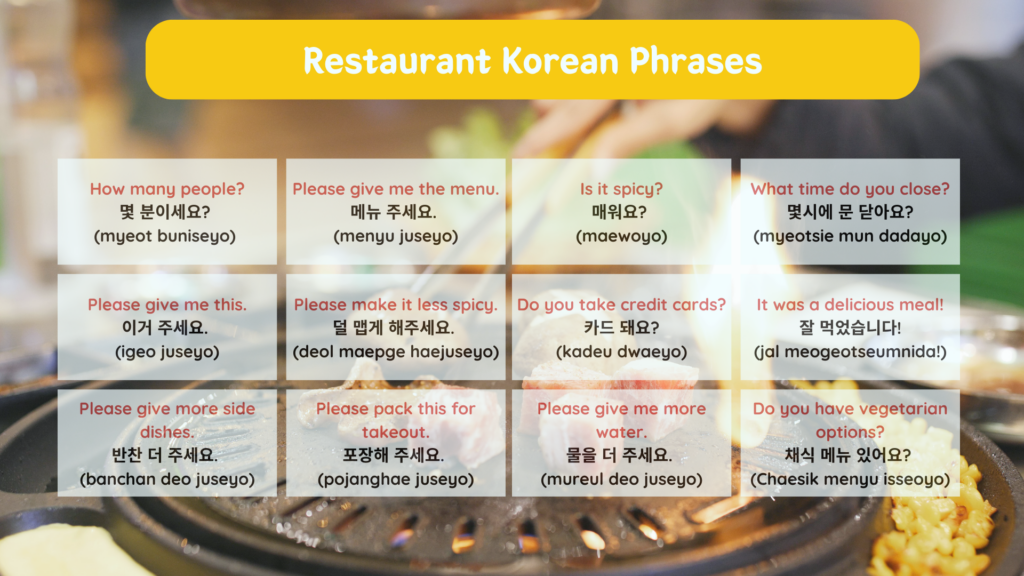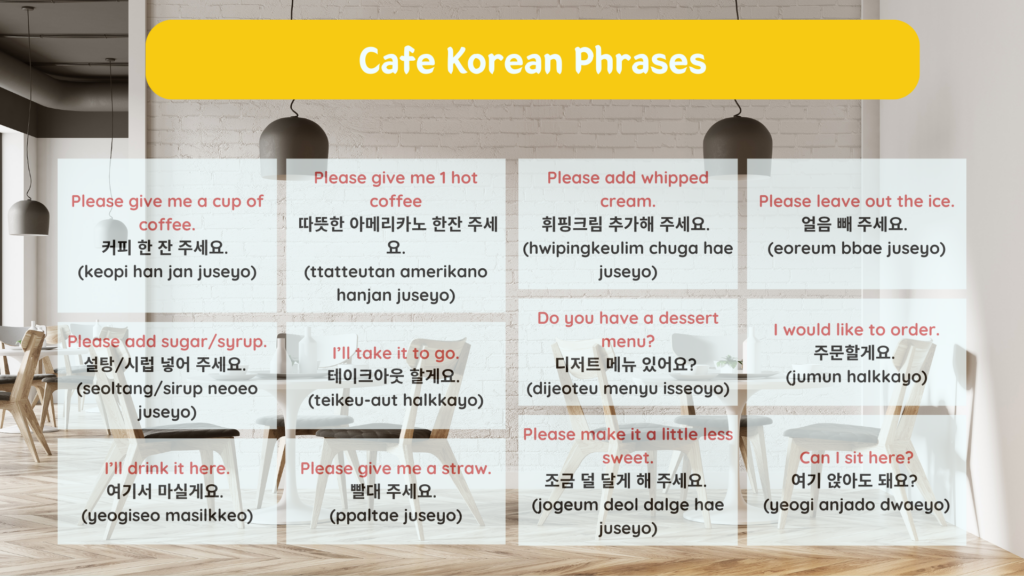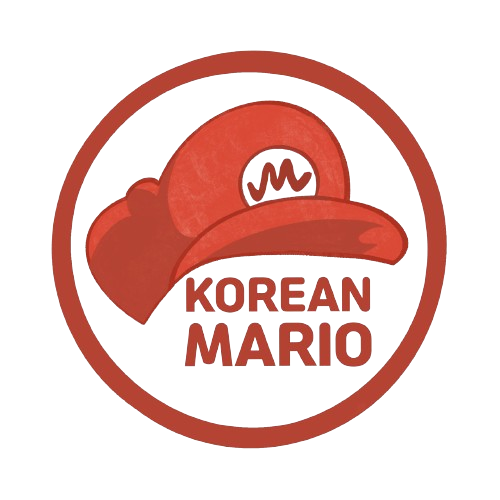Korea is a country rich in culture, history, and vibrant daily life. For anyone visiting or living in Korea, understanding and using common Korean expressions can significantly enhance the experience. Whether you are at a bustling market, a serene temple, a cozy café, or navigating the public transport system, knowing the right expressions can help you connect with locals, make new friends, and navigate daily interactions with ease. In this blog, we will explore essential Korean expressions tailored for different venues and locations, helping you immerse yourself fully in the dynamic and diverse life of Korea.
Restaurant Korean Phrases

Click on the 🔊 or the Hangul word to listen to the pronunciation.
Waiter/Waitress
| 🔊 | Welcome. 어서 오세요. (eoseo oseyo) |
| 🔊 | How many people? 몇 분이세요? (myeot buniseyo) |
| 🔊 | Did you make a reservation? 예약하셨어요? (yeyakha syeossoyo) |
| 🔊 | Would you like to order? 주문하시겠어요? (jumun hasigesseoyo) |
| 🔊 | What would you like to drink? 음료는 뭐로 드릴까요? (eumnyoneun muero deurilkkayo) |
| 🔊 | Would you like it spicy? 맵게 해드릴까요? (map ge haedeurilggayo) |
| 🔊 | Do you need anything else? 더 필요하신거 있으세요? (deo pillyohashin geo isseuse yo) |
| 🔊 | Would you like it for takeout? 포장해 드릴까요? (pojanghae deurilkkayo) |
| 🔊 | Can I help with the bill? 계산 도와드릴까요? (gyesan doawadeurilkkayo) |
| 🔊 | Would you like a receipt? 영수증 드릴까요? (yeongsujeung deurilkkayo) |
| 🔊 | Please come again next time! 다음에 또 오세요! (daeume tto oseyo) |
| 🔊 | Thank you. Have a nice day. 감사합니다. 좋은하루 되세요. (gamsahabnida joeun haru doeseyo) |
Customers
| 🔊 | Please give me the menu. 메뉴 주세요. (menyu juseyo) |
| 🔊 | Please recommend something. 추천해 주세요. (chucheonhae juseyo) |
| 🔊 | Please give me this. 이거 주세요. (igeo juseyo) |
| 🔊 | Please give me more water. 물 좀 더 주세요. (mul jom deo juseyo) |
| 🔊 | Please make it less spicy. 덜 맵게 해주세요. (deol maepge haejuseyo) |
| 🔊 | Please give more side dishes. 반찬 좀 더 주세요. (banchan jom deo juseyo) |
| 🔊 | Please pack this for takeout. 포장해 주세요. (pojanghae juseyo) |
| 🔊 | Is it spicy? 매워요? (maewoyo) |
| 🔊 | Do you have vegetarian options? 채식 메뉴 있어요? (Chaesik menyu isseoyo) |
| 🔊 | Do you have a table for 4 people? 네명 자리 있어요? (nemyeong jari isseoyo) |
| 🔊 | Please give me four servings of pork belly. 삼겹살 사인분 주세요 (samgyeopsal sainbun juseyo) |
| 🔊 | Please give me 1 bottle of soju. 소주 한병 주세요 (soju hanbyeong juseyo) |
| 🔊 | What time do you close? 몇시에 문 닫아요? (myeotsie mun dadayo) |
| 🔊 | Do you take credit cards? 카드 돼요? (kadeu dwaeyo) |
| 🔊 | It was a delicious meal! 잘 먹었습니다! (jal meogeotseumnida!) |
Mastering daily Korean expressions for various venues and locations not only facilitates smoother interactions but also enriches your cultural experience in Korea.
By using these expressions, you demonstrate respect and appreciation for Korean culture, which can open doors to deeper connections and more meaningful experiences. Whether you’re exploring the vibrant streets of Seoul, enjoying the tranquility of a countryside village, or savoring delicious street food, these expressions will be your gateway to a more immersive and enjoyable journey.
So, practice these phrases, embrace the local customs, and make the most out of your time in Korea.
Cafe Korean Phrases

Cafés play a significant role in Korean culture, often serving as cozy retreats where people relax, socialize, and even fall in love. Korean dramas frequently feature charming café scenes, where characters share heartfelt conversations over steaming cups of coffee or indulge in delectable desserts.
Click on the 🔊 or the Hangul word to listen to the pronunciation.
Barista/Cafe Staff
| 🔊 | Would you like to order? 주문하시겠어요? (jumun hasigesseoyo) |
| 🔊 | What size do you want? 사이즈 어떤걸로 드릴까요? (saiz eoddeongeolro deurilkkayo) |
| 🔊 | Would you like to add sugar or syrup? 설탕이나 시럽 추가해 드릴까요? (seoltangina sirub chugahe deurilkkayo?) |
| 🔊 | Will you have it here? 여기서 드세요? (yeogiseo deuseyo?) |
| 🔊 | Do you need anything else? 더 필요하신거 있으세요? (deo pillyohashin geo isseuseyo) |
| 🔊 | Would you like it for takeout? 포장해 드릴까요? (pojanghae deurilkkayo) |
| 🔊 | Can I help with the bill? 계산 도와드릴까요? (gyesan doawadeurilkkayo) |
| 🔊 | Do you need a receipt? 영수증 필요하세요? (yeongsujeung piryohaseyo) |
| 🔊 | Would you like whipped cream on top? 휘핑 크림을 올릴까요? (hwiping keurimeul olrilkkayo?) |
| 🔊 | Please come again next time! 다음에 또 오세요! (daeume tto oseyo) |
| 🔊 | Do you have a point card? 포인트 카드 있으세요? (point kadeu yi sseu se yo) |
Customers
| 🔊 | Please give me a cup of coffee. 커피 한 잔 주세요. (keopi han jan juseyo) |
| 🔊 | Please give me an iced Americano. 아이스 아메리카노 주세요. (aiseu Amerikan juseyo) |
| 🔊 | Please give me 1 hot coffee 따뜻한 아메리카노 한잔 주세요. (ttatteutan amerikano hanjan juseyo) |
| 🔊 | Please give me a latte. 라떼 하나 주세요. (latte hana juseyo) |
| 🔊 | Please add sugar/syrup. 설탕/시럽 넣어 주세요. (seoltang/sirup neoeo juseyo) |
| 🔊 | Please add one more shot. 샷 하나 추가해 주세요 (shat hana chugahae juseyo) |
| 🔊 | I’ll take it to go. 테이크아웃 할게요. (teikeu-aut halkkayo) |
| 🔊 | I’ll drink it here. 여기서 마실게요. (yeogiseo masilkkeo) |
| 🔊 | Please pack this for takeout. 포장해 주세요. (pojanghae juseyo) |
| 🔊 | Please give me a straw. 빨대 주세요. (ppaltae juseyo) |
| 🔊 | Please add whipped cream. 휘핑크림 추가해 주세요. (hwipingkeulim chuga hae juseyo) |
| 🔊 | Please leave out the ice. 얼음 빼 주세요. (eoreum bbae juseyo) |
| 🔊 | Do you have a dessert menu? 디저트 메뉴 있어요? (dijeoteu menyu isseoyo) |
| 🔊 | Please give me a receipt. 영수증 주세요. (yeongsujeung juseyo) |
| 🔊 | I would like to order. 주문할게요. (jumun halkkayo) |
| 🔊 | Please give me a bread/pastry. 빵 하나 주세요. (ppang hana juseyo) |
| 🔊 | Please give me a piece of cake. 케이크 한 조각 주세요. (keikeu han jogak juseyo) |
| 🔊 | Please make it a little less sweet. 조금 덜 달게 해 주세요. (jogeum deol dalge hae juseyo) |
| 🔊 | Can I sit here? 여기 앉아도 돼요? (yeogi anjado dwaeyo) |
| 🔊 | What is the Wi-Fi password? 와이파이 비밀번호 뭐예요? (waipai bimilbeonho mwoyeyo) |
These settings are not only aesthetically pleasing but also pivotal in advancing the storyline and deepening character relationships. Whether you’re a fan of K
Table of Contents

